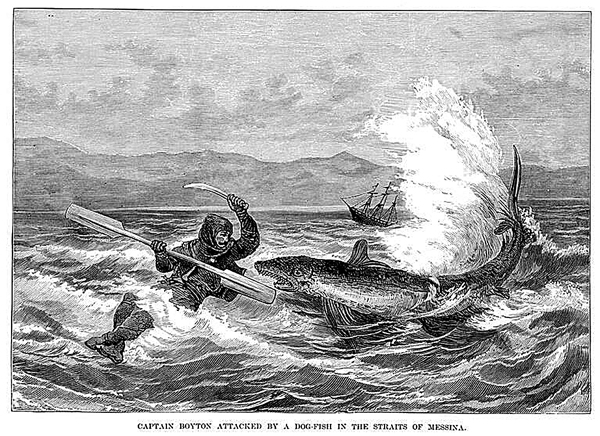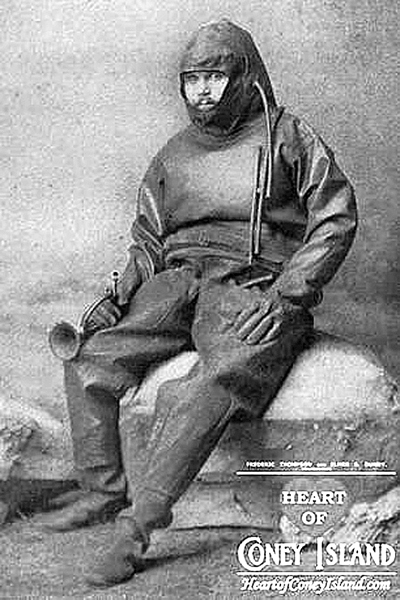

Ken Springer
Watoga Park Foundation
The World’s Greatest Forgotten Adventurer
It is said that we die twice. Once, when we physically die, and we experience our final death when our name is no longer spoken.
You have probably never heard of Paul Boyton. In a recent small-sample survey, not one respondent knew who he was.
I first became aware of his incredible feats nearly two decades ago from a short article in an airline magazine. My first thought after reading the piece was, “How is it that I have never heard of him?”
The one-page article focused solely upon a period in Boyton’s life in the late 1800s when he floated down rivers throughout the world in a waterproof rubber suit. As incredible as that feat is, it is just a tiny portion of his résumé that includes everything from a successful stint with the Barnum Circus to creating the first amusement park.
Boyton’s list of accomplishments catapulted him to world fame a century ago. He was the consummate showman and daredevil much in the genre of Buffalo Bill and Annie Oakley, and like them, not averse to rigorously promoting himself.
But when you weigh the scope and breadth of Boyton’s accomplishments, his shameless self-promotion does not detract from his stature among the world’s greatest adventurers.
His stunts would be unbelievable if not for the documentation his fame assured. Many of the rivers he floated in his rubber dress were wild and uncharted.
In 1882, Boyton floated the combined 3,580 miles of the Yellowstone and Missouri Rivers from Glendive, Montana, to St. Louis, Missouri. At every fort he passed, soldiers and Indians alike would line the riverbank to greet him. Boyton encountered many hazards on this, his longest and most dangerous river descent.
The Missouri River was still wild with hostile tribes, evidenced by those taking potshots at him along the way. The river’s currents were treacherous and undercut banks threatened to bury the voyager at any moment. Not having started his trip until mid-September, the water was getting progressively colder each day.
Many of his numerous river descents throughout the world offered the frequent potential for death. Yet, somehow this brave soul always arrived at his journey’s end unscathed. That fact is amazing, considering he ran every major river in Europe and America despite their many hazards.
A discussion of his floating suit is called for at this point, as I am sure you are trying to imagine how such a contraption works.
The rubber dress, as it was then called, was a prototype of the modern survival suit (Gumby Suit) found on many fishing boats operating in northern waters. Survival time in these cold waters without an immersion suit is less than 30 minutes.
Bolton’s suit was invented by C.S. Merriman in 1872 and patented as an “improved life-preserving dress.” It was a forerunner of the modern wetsuit. The suit, made of vulcanized rubber, consisted of a top and bottom piece. The two parts were joined at the waist and made waterproof by a metal band that could be tightened.
Flotation provided by a series of air bladders could be inflated orally through a tube. An air sack behind the head provided the wearer with comfortable head support, an important feature when you consider that Boyton often floated 36 hours straight without going ashore.
Air bladders along the sides and legs maintained the wearer in a comfortable position even in rough water. The only parts of the body exposed to the elements were the eyes, nose, and mouth.
It was a fortunate thing that his mouth was exposed because Boyton carried a bugle at the ready. Many were the times that he would observe both whites and Indians in the act of raising a gun with the intention of shooting at him. The bugle served to alert the would-be murderers and scare off the occasional curious grizzly bear venturing too close.
One must imagine that, in the 1880s, the large black form of some weird sea creature floating by may have, at the very least, drawn attention, if not a bullet.
But there was a method to Boyton’s madness. The daring river and ocean voyages were designed to draw attention to the suit in the hopes that he could sell them to those traveling on passenger ships.
This has been compared to selling parachutes to passengers on airlines today. Instead of purchasing airline insurance, just buy a parachute from the flight attendant along with your coffee and pastry.
So, was the Fearless Frogman a bit non compos mentis? Not at all. Paul Boyton was a showman and entrepreneur with few peers, and he possessed a keen sense of how to draw crowds.
As well, he truly wanted to promote water sports and protect people from drowning. He helped organize and served as captain of the United States Lifesaving Service, the forerunner of the U.S. Coast Guard.
As testament to his penchant for being in and around water, he enlisted in the Union Navy during the Civil War – he was 15 years old at the time. He went on to join the Mexican Navy, followed by a stint with the French Navy during the Franco-Prussian conflict.
His crossing of the English Channel in his immersion suit brought accolades and an opportunity to demonstrate the flotation device to Queen Victoria. His feat initiated the severe challenge of swimming the channel that continues to this very day.
In 1885 Boyton’s aquatic act became a major attraction in Barnum’s Circus. He trumped this success by building the world’s first amusement park in Chicago called “The Chutes,” a wild water ride – also a first.
A few years later, Boyton sold The Chutes and opened up Sea Lion Park at Coney Island. This was the first amusement park to charge a single ticket price to enter.
A full listing of Boyton’s exploits and credits far exceed the space allotted in this column. The sheer number of this individual’s achievements would require many lifetimes for others to accomplish.
But for some reason, Boyton’s fame did not enjoy the longevity of many others who achieved much less.
Some may say that he was obsessed. But there are those among us who possess a drive to accomplish as much as possible in the time life grants to us. Boyton was undoubtedly one of them.
Paul Boyton experienced his physical death in New York City in 1924.
Well, Mr. Boyton, this composition is intended to keep that final form of death at bay a bit longer. Readers of The Pocahontas Times will now have a novel topic and a new name to bring up at their next cocktail party. But they will have to wait until this d%#n pandemic is over.
Postscript: I rummaged around in my basement today, finding my old diving wetsuit to be in relatively good condition. I can already see the headlines next summer: Seebert man floats the entire length of the Greenbrier River in a rubber suit. Survives attack by hostile geese!
This edition of the Watoga Trail Report is dedicated to my dear friend, Jerry Bever. Mr. Bever may very well be the reincarnation of Paul Boyton. The two men are of a kindred spirit regarding their sense of adventure, and they both approached life with unceasing curiosity.
Ken Springer
Ken1949bongo@gmail.com



